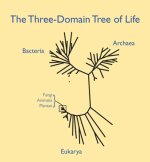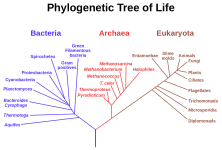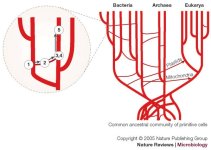Yes, the exact "rooting" of microbial phyla is still unclear. Notice that in the tree you posted, the relationship is left ambiguous - the tree is unrooted. Check out this tree:
View attachment 2955
http://en.wikipedia.org/wiki/Phylogenetic_tree
If you check out the link, you'll see that it is described as "speculative." The exact relationship between microbial phyla is pretty contentious at the moment, which makes sense since the gene-sequencing tools necessary for any proper treatment of the subject weren't really developed and widely available until at least the late 70's.
Here's another snippet that illustrates the current state of the controversy:
The relationship between the three domains is of central importance for understanding the origin of life. Most of the metabolic pathways, which comprise the majority of an organism's genes, are common between Archaea and Bacteria, while most genes involved in genome expression are common between Archaea and Eukarya.[51] Within prokaryotes, archaeal cell structure is most similar to that of gram-positive bacteria, largely because both have a single lipid bilayer[52] and usually contain a thick sacculus of varying chemical composition.[53] In some phylogenetic trees based upon different gene/protein sequences of prokaryotic homologs, the archaeal homologs are more closely related to those of gram-positive bacteria.[52] Archaea and gram-positive bacteria also share conserved indels in a number of important proteins, such as Hsp70 and glutamine synthetase I;[52][54] however, the phylogeny of these genes was interpreted to reveal interdomain gene transfer,[55][56] and might not reflect the organismal relationships.
http://en.wikipedia.org/wiki/Archaea#Relationship_to_other_prokaryotes
The reality is that a "tree" is probably not an appropriate structure to describe the relationship between all of life on Earth. The history of life, especially this scale, includes a lot of horizontal gene transfer and endosymbiosis.






